The Implementation of Climate Change Policy in Post-Soviet Countries Achieving Long-Term Targets
Abstract
1. Introduction
2. Literature Review
2.1. Post-Soviet Countries
2.2. Climate Change Policy and Main Aspects
2.3. Forecasts of Climate Change Policy Targets
3. Methods and Data
4. Results and Discussion
4.1. Energy Consumption and Greenhouse Gas Emissions in Post-Soviet Countries
4.2. Forecasts of Carbon Dioxide Emissions by 2035
4.3. Forecasts of Energy Intensity by 2035
4.4. Forecasts of the Share of Renewable Energy by 2035
5. Conclusions
Author Contributions
Funding
Acknowledgments
Conflicts of Interest
References
- Vaughan, A. Climate protest goes global. New Sci. 2019, 241, 7. [Google Scholar] [CrossRef]
- UNFCC. The Paris Agreement. Available online: https://unfccc.int/process-and-meetings/the-paris-agreement/the-paris-agreement (accessed on 13 February 2020).
- Liobikienė, G.; Butkus, M. The European Union possibilities to achieve targets of Europe 2020 and Paris agreement climate policy. Renew. Energy 2017, 106, 298–309. [Google Scholar] [CrossRef]
- Yuan, X.-C.; Sun, X.; Zhao, W.; Mi, Z.; Wang, B.; Wei, Y.-M. Forecasting China’s regional energy demand by 2030: A Bayesian approach. Resour. Conserv. Recycl. 2017, 127, 85–95. [Google Scholar] [CrossRef]
- Xu, L.; Chen, N.; Chen, Z. Will China make a difference in its carbon intensity reduction targets by 2020 and 2030? Appl. Energy 2017, 203, 874–882. [Google Scholar] [CrossRef]
- Li, F.; Xu, Z.; Ma, H. Can China achieve its CO2 emissions peak by 2030? Ecol. Indic. 2018, 84, 337–344. [Google Scholar] [CrossRef]
- Tan, X.; Dong, L.; Chen, D.; Gu, B.; Zeng, Y. China’s regional CO2 emissions reduction potential: A study of Chongqing city. Appl. Energy 2016, 162, 1345–1354. [Google Scholar] [CrossRef]
- Niu, D.; Wang, K.; Wu, J.; Sun, L.; Liang, Y.; Xu, X.; Yang, X. Can China achieve its 2030 carbon emissions commitment? Scenario analysis based on an improved general regression neural network. J. Clean. Prod. 2020, 243, 118558. [Google Scholar] [CrossRef]
- Zeng, S.; Chen, J. Forecasting the Allocation Ratio of Carbon Emission Allowance Currency for 2020 and 2030 in China. Sustainability 2016, 8, 650. [Google Scholar] [CrossRef]
- Brizga, J.; Feng, K.; Hubacek, K. Drivers of CO2 emissions in the former Soviet Union: A country level IPAT analysis from 1990 to 2010. Energy 2013, 59, 743–753. [Google Scholar] [CrossRef]
- Schierhorn, F.; Kastner, T.; Kuemmerle, T.; Meyfroidt, P.; Kurganova, I.; Prishchepov, A.V.; Erb, K.-H.; Houghton, R.A.; Müller, D. Large greenhouse gas savings due to changes in the post-Soviet food systems. Environ. Res. Lett. 2019, 14, 065009. [Google Scholar] [CrossRef]
- Bae, J.H.; Li, D.D.; Rishi, M. Determinants of CO2 emission for post-Soviet Union independent countries. Clim. Policy 2016, 17, 591–615. [Google Scholar] [CrossRef]
- Jorgenson, A.; Schor, J. Income Inequality and Carbon Emissions in Post-Soviet Nations, 1992–2009. Ekonom 2017, 96, 33–43. [Google Scholar] [CrossRef]
- Barrett, T.; Feola, G.; Khusnitdinova, M.; Krylova, V. Adapting Agricultural Water Use to Climate Change in a Post-Soviet Context: Challenges and Opportunities in Southeast Kazakhstan. Hum. Ecol. 2017, 45, 747–762. [Google Scholar] [CrossRef]
- Ashley, L.; Zhumanova, M.; Isaeva, A.; Dear, C. Examining changes in local adaptive capacity resulting from climate change adaptation programming in rural Kyrgyzstan. Clim. Dev. 2015, 8, 281–287. [Google Scholar] [CrossRef]
- Bruno, A. Climate history of Russia and the Soviet Union. Wiley Interdiscipl. Rev. Clim. Chang. 2018, 9, 534. [Google Scholar] [CrossRef]
- IEA. Energy Policies Beyond IEA Countries: Ukraine 2012. Available online: https://www.iea.org/reports/energy-policies-beyond-iea-countries-ukraine-2012 (accessed on 13 February 2020).
- Child, M.; Breyer, C.; Bogdanov, D.; Fell, H.-J. The role of storage technologies for the transition to a 100% renewable energy system in Ukraine. Energy Procedia 2017, 135, 410–423. [Google Scholar] [CrossRef]
- Moya, J.A.; Pardo, N. The potential for improvements in energy efficiency and CO2 emissions in the EU27 iron and steel industry under different payback periods. J. Clean. Prod. 2013, 52, 71–83. [Google Scholar] [CrossRef]
- Pardo, N.; Moya, J.A. Prospective scenarios on energy efficiency and CO2 emissions in the European Iron & Steel industry. Energy 2013, 54, 113–128. [Google Scholar]
- Streimekiene, D. The impact of international GHG trading regimes on penetration of new energy technologies and feasibility to implement EU Energy and Climate Package targets. Renew. Sustain. Energy Rev. 2012, 16, 2172–2177. [Google Scholar] [CrossRef]
- Holt, L.; Galligan, M. Energy efficiency policies as part of carbon reduction efforts: Lessons from the EU for the U.S. Electr. J. 2013, 26, 33–42. [Google Scholar] [CrossRef]
- Blesl, M.; Kobert, T.; Bruchof, D.; Kuder, R. Effects of climate and energy policy related measure and targets on the future structure of the European energy system in 2020 and beyond. Energy Policy 2010, 38, 6278–6292. [Google Scholar] [CrossRef]
- Siitonen, S.; Tuomaala, M.; Suominen, M.; Ahtila, P. Implications of process energy efficiency improvements for primary energy consumption and CO2 emissions at the national level. Appl. Energy 2010, 87, 2928–2937. [Google Scholar] [CrossRef]
- Özbuğday, F.C.; Erbas, B.C. How effective are energy efficiency and renewable energy in curbing CO2 emissions in the long run? A heterogeneous panel data analysis. Energy 2015, 82, 734–745. [Google Scholar] [CrossRef]
- Wang, Q.; Chiu, Y.H.; Chiu, C.R. Driving factors behind carbon dioxide emissions in China: A modified production theoretical decomposition analysis. Energy Econ. 2015, 51, 252–260. [Google Scholar] [CrossRef]
- Liobikienė, G.; Butkus, M. Environmental Kuznets Curve of greenhouse gas emissions including technological progress and substitution effects. Energy 2017, 135, 237–248. [Google Scholar] [CrossRef]
- Liobikienė, G.; Butkus, M. Scale, composition, and technique effects through which the economic growth, foreign direct investment, urbanization, and trade affect greenhouse gas emissions. Renew. Energy 2019, 132, 1310–1322. [Google Scholar] [CrossRef]
- Picazo-Tadeo, A.J.; Castillo-Gimenez, J.; Beltr an-Esteve, M. An intertemporal approach to measuring environmental performance with directional distance functions: Greenhouse gas emissions in the European Union. Ecol. Econ. 2014, 100, 173–182. [Google Scholar] [CrossRef]
- Streimikiene, D.; Balezentis, T.; Krisciukaitienė, I. Promoting interactions between local climate change mitigation, sustainable energy development, and rural development policies in Lithuania. Energy Policy 2012, 50, 699–710. [Google Scholar] [CrossRef]
- Liobikienė, G.; Butkus, M.; Bernatonienė, J. Drivers of greenhouse gas emissions in the Baltic states: Decomposition analysis related to the implementation of Europe 2020 strategy. Renew. Sustain. Energy Rev. 2016, 54, 309–317. [Google Scholar] [CrossRef]
- Fernández González, P.; Landajo, M.; Presno, M.J. The driving forces behind changes in GHG emission levels in EU-27. Differences between member states. Environ. Sci. Policy 2014, 38, 11–16. [Google Scholar] [CrossRef]
- Bӧlük, G.; Mert, M. Fossil & renewable energy consumption, GHGs (greenhouse gases) and economic growth: Evidence from a panel of EU (European Union) countries. Energy 2014, 74, 439–446. [Google Scholar]
- Bӧlük, G.; Mert, M. The renewable energy, growth and environmental Kuznets curve in Turkey: An ARDL approach. Renew. Sustain. Energy Rev. 2015, 52, 587–595. [Google Scholar] [CrossRef]
- Marrero, G.A. Greenhouse gases emissions, growth and the energy mix in Europe. Energy Econ. 2010, 32, 1356–1363. [Google Scholar] [CrossRef]
- Dogan, E.; Seker, F. Determinants of CO2 emissions in the European Union: The role of renewable and non-renewable energy. Renew. Energy 2016, 94, 429–439. [Google Scholar] [CrossRef]
- Al-Mulali, U.; Ozturk, I.; Solarin, S.A. Investing the environmental Kuznets curve hypothesis in seven regions: The role of renewable energy. Ecol. Indic. 2016, 67, 267–282. [Google Scholar] [CrossRef]
- Baležentis, T.; Štreimikienė, D.; Melnikienė, R.; Zeng, S. Prospects of green growth in the electricity sector in Baltic States: Pinch analysis based on ecological footprint. Resources. Conserv. Recycl. 2019, 142, 37–48. [Google Scholar] [CrossRef]
- Bilgili, F.; Kocak, E.; Bulut, U. The dynamic impact of renewable energy consumption on CO2 emissions: A revised Environmental Kuznets Curve approach. Renew. Sustain. Energy Rev. 2016, 54, 838–845. [Google Scholar] [CrossRef]
- Menyah, K.; Wolde-Rufael, Y. CO2 emissions, nuclear energy, renewable energy and economic growth in the US. Energy Policy 2010, 38, 2911–2915. [Google Scholar] [CrossRef]
- Jaforullah, M.; King, A. Does the use of renewable energy sources mitigate CO2 emissions? A reassessment of the US evidence. Energy Econ. 2015, 49, 711–717. [Google Scholar] [CrossRef]
- EEA (European Environment Agency). Available online: https://www.eea.europa.eu/publications/ghg-trends-and-projections-2012 (accessed on 13 February 2020).
- Capros, P.; Tasios, N.; De Vita, A.; Mantzos, L.; Paroussos, L. Model-based analysis of decarbonising the EU economy in the time horizon to 2050. Energy Strategy Rev. 2012, 1, 76–84. [Google Scholar] [CrossRef]
- Höglund-Isaksson, L.; Winiwarter, W.; Purohit, P.; Rafaj, P.; Schöpp, W.; Klimont, Z. EU low carbon roadmap 2050: Potentials and costs for mitigation of non-CO2 greenhouse gas emissions. Energy Strategy Rev. 2012, 1, 97–108. [Google Scholar] [CrossRef]
- Höbler, N.; Löschel, A. The EU Decarbonisation Roadmap 2050 What way to walk? Energy Policy 2013, 55, 190–207. [Google Scholar] [CrossRef]
- Streimikiene, D.; Roos, I. GHG emission trading implications on energy sector in Baltic States. Renew. Sustain. Energy Rev. 2009, 13, 854–862. [Google Scholar] [CrossRef]
- Smit, A.B.; Hu, J.; Harmsen, R. Unravelling projected energy savings in 2020 of the EU Members States using decomposition analyzes. Energy Policy 2014, 74, 271–285. [Google Scholar] [CrossRef]
- Giacomarra, M.; Bono, F. European Union commitment towards RES market penetration: From the first legislative acts to the publication of the recent guidelines on State aid 2014/2020. Renew. Sustain. Energy Rev. 2015, 47, 218–232. [Google Scholar] [CrossRef]
- Wu, L.; Liu, S.; Liu, D.; Fang, Z.; Xu, H. Modelling and forecasting CO2 emissions in the BRICS (Brazil, Russia, India, China, and South Africa) countries using a novel multi-variable grey model. Energy 2015, 79, 489–495. [Google Scholar] [CrossRef]
- Samoilov, I.A.; Nakhutin, A.I. Estimation and medium-term forecasting of anthropogenic carbon dioxide and methane emission in Russia with statistical methods. Rus. Meteorol. Hydrol. 2009, 34, 348–353. [Google Scholar] [CrossRef]
- Pao, H.-T.; Fu, H.-C.; Yu, H.-C. Forecasting Russian renewable, nuclear, and total energy consumption using improved nonlinear grey Bernoulli model. Intern. J. Comput. Sci. Issues 2013, 10, 689–694. [Google Scholar]
- Kerimray, A.; Baigarin, K.; De Miglio, R.; Tosato, G. Climate change mitigation scenarios and policies and measures: The case of Kazakhstan. Clim. Policy 2015, 16, 332–352. [Google Scholar] [CrossRef]
- Xiong, C.; Yang, D.; Huo, J.; Zhao, Y. The relationship between energy consumption and economic growth and the development strategy of a low-carbon economy in Kazakhstan. J. Arid Land 2015, 7, 706–715. [Google Scholar] [CrossRef]
- Karatayev, M.; Clarke, M.L. Current energy resources in Kazakhstan and the future potential of renewables: A review. Energy Procedia 2014, 59, 97–104. [Google Scholar] [CrossRef]
- Karatayev, M.; Clarke, M.L. A review of current energy systems and green energy potential in Kazakhstan. Renew. Sustain. Energy Rev. 2016, 55, 491–504. [Google Scholar] [CrossRef]
- Hasanov, F.; Hunt, L.; Mikayilov, C. Modeling and Forecasting Electricity Demand in Azerbaijan Using Cointegration Techniques. Energy 2016, 9, 1045. [Google Scholar] [CrossRef]
- Gómez, A.; Dopazo, C.; Fueyo, N. The future of energy in Uzbekistan. Energy 2015, 85, 329–338. [Google Scholar] [CrossRef]
- Saidmamatov, O.; Salaev, S. Renewable energy potential of developing countries: The drivers towards a green economy (a case study from Uzbekistan). Int. J. Green Econ. 2014, 8, 134–143. [Google Scholar] [CrossRef]
- Diachuk, O. Forecasting and evaluation of direct GHG emissions with the use of “TIMES-UKRAINE” model. Mark. Forecast Mark. 2013, 4, 116–127. [Google Scholar]
- Kurbatova, T.; Khlyap, H. GHG emissions and economic measures for low carbon growth in Ukraine. Carbon Manag. 2015, 6, 7–17. [Google Scholar] [CrossRef]
- Rogelj, J.; den Elzen, M.; Höhne, N.; Fransen, T.; Fekete, H.; Winkler, H.; Meinshausen, M. Paris Agreement climate proposals need a boost to keep warming well below 2 °C. Nature 2016, 534, 631–639. [Google Scholar] [CrossRef] [PubMed]
- Höhne, N.; Kuramochi, T.; Warnecke, C.; Röser, F.; Fekete, H.; Hagemann, M.; Gonzales, S. The Paris Agreement: Resolving the inconsistency between global goals and national contributions. Clim. Policy 2016, 17, 16–32. [Google Scholar] [CrossRef]
- Yang, M.; Cela, B.; Yang, F. Innovative energy policy to transform energy systems in Ukraine. Mitig. Adapt. Strateg. Glob. Chang. 2019, 24, 907–939. [Google Scholar] [CrossRef]
- Chepeliev, M.; Diachuk, O.; Podolets, R. Economic Assessment of Low-Emission Development Scenarios for Ukraine. Limiting Global Warming to Well Below 2 °C. Energy 2018, 64, 277–295. [Google Scholar]
- Chernyak, O.; Kharlamova, G.; Stavytskyy, A. Energy Perspective 2030 for Ukraine in the Context of the EU Integration. Springer Proc. Bus. Econ. 2018, 64, 113–129. [Google Scholar]
- Diachuk, O.; Podolets, R.; Yukhymets, R.; Pekkoiev, V.; Balyk, O.; Simonsen, M. Long-Term Energy Modelling and Forecasting in Ukraine: Scenarios for the Action Plan of Energy Strategy of Ukraine until 2035; Final Report; Technical University of Denmark: Kyiv, Ukraine; Copenhagen, Denmark, 2019; pp. 2–52. [Google Scholar]
- The World Bank Data. Available online: https://data.worldbank.org/ (accessed on 16 February 2020).
- Eurostat. Available online: https://ec.europa.eu/eurostat/tgm/table.do?tab=table&init=1&language=en&pcode=sdg_07_10&plugin=1 (accessed on 16 February 2020).
- Intended Nationally Determined Contribution of the Republic of Belarus. Available online: http://minpriroda.gov.by/uploads/files/Belarus-INDC-Eng.pdf (accessed on 15 February 2020).
- The Concept of Energy Security by 2035 of the Republic of Belarus. Available online: http://www.government.by/ru/solutions/2337 (accessed on 15 February 2020).
- Intended Nationally Determined Contribution of the Republic of Moldova. Available online: https://www4.unfccc.int/sites/ndcstaging/PublishedDocuments/Republic%20of%20Moldova%20First/INDC_Republic_of_Moldova_25.09.2015.pdf (accessed on 15 February 2020).
- Intended Nationally Determined Contribution of the Republic of Ukraine. Available online: https://www4.unfccc.int/sites/ndcstaging/PublishedDocuments/Ukraine%20First/Ukraine%20First%20NDC.pdf (accessed on 15 February 2020).
- The Strategy of the State Environmental policy of Ukraine for the Period by 2030. Available online: https://zakon.rada.gov.ua/laws/show/2697-19#n14 (accessed on 15 February 2020).
- Intended Nationally Determined Contribution of the Russian Federation. Available online: https://www4.unfccc.int/sites/submissions/indc/Submission%20Pages/submissions.aspx (accessed on 15 February 2020).
- Russian Energy Strategy for the Period by 2035. Available online: https://ac.gov.ru/files/content/1578/11-02-14-energostrategy-2035-pdf.pdf (accessed on 15 February 2020).
- Intended Nationally Determined Contribution of the Republic of Armenia. Available online: https://www4.unfccc.int/sites/ndcstaging/PublishedDocuments/Armenia%20First/INDC-Armenia.pdf (accessed on 15 February 2020).
- Intended Nationally Determined Contribution of the Republic of Azerbaijan. Available online: https://www4.unfccc.int/sites/ndcstaging/PublishedDocuments/Azerbaijan%20First/INDC%20Azerbaijan.pdf (accessed on 15 February 2020).
- The CAREC Energy Strategy 2030. Available online: https://www.adb.org/sites/default/files/institutional-document/536941/carec-energy-strategy-2030.pdf (accessed on 15 February 2020).
- Intended Nationally Determined Contribution of the Republic of Georgia. Available online: https://www4.unfccc.int/sites/ndcstaging/PublishedDocuments/Georgia%20First/INDC_of_Georgia.pdf (accessed on 15 February 2020).
- Intended Nationally Determined Contributions of the Republic of Kazakhstan. Available online: https://www4.unfccc.int/sites/ndcstaging/PublishedDocuments/Kazakhstan%20First/INDC%20Kz_eng.pdf (accessed on 15 February 2020).
- Kazakhstan Transition to “Green Economy” Plan. Available online: https://policy.asiapacificenergy.org/sites/default/files/Concept%20on%20Transition%20towards%20Green%20Economy%20until%202050%20%28EN%29.pdf (accessed on 15 February 2020).
- Intended Nationally Determined Contributions of the Kyrgyz Republic. Available online: https://www4.unfccc.int/sites/submissions/INDC/Published%20Documents/Kyrgyzstan/1/Kyrgyzstan%20INDC%20_ENG_%20final.pdf (accessed on 15 February 2020).
- Intended Nationally Determined Contributions of the Republic of Tajikistan. Available online: https://www4.unfccc.int/sites/ndcstaging/PublishedDocuments/Tajikistan%20First/INDC-TJK%20final%20ENG.pdf (accessed on 15 February 2020).
- Intended Nationally Determined Contributions of the Republic of Turkmenistan. Available online: https://www4.unfccc.int/sites/ndcstaging/PublishedDocuments/Turkmenistan%20First/INDC_Turkmenistan.pdf (accessed on 15 February 2020).
- Intended Nationally Determined Contributions of the Republic of Uzbekistan. Available online: https://www4.unfccc.int/sites/ndcstaging/PublishedDocuments/Uzbekistan%20First/INDC%20Uzbekistan%2018-04-2017_Eng.pdf (accessed on 15 February 2020).
- Summary of the Commission Assessment of the Draft National Energy and Climate Plan 2021–2030 (Estonia). Available online: https://ec.europa.eu/energy/sites/ener/files/documents/necp_factsheet_ee_final.pdf (accessed on 15 February 2020).
- Summary of the Commission assessment of the draft National Energy and Climate Plan 2021–2030 (Latvia). Available online: https://ec.europa.eu/energy/sites/ener/files/documents/necp_factsheet_lv_final.pdf (accessed on 15 February 2020).
- Summary of the Commission Assessment of the Draft National Energy and Climate Plan 2021–2030 (Lithuania). Available online: https://ec.europa.eu/energy/sites/ener/files/documents/necp_factsheet_lt_final.pdf (accessed on 15 February 2020).
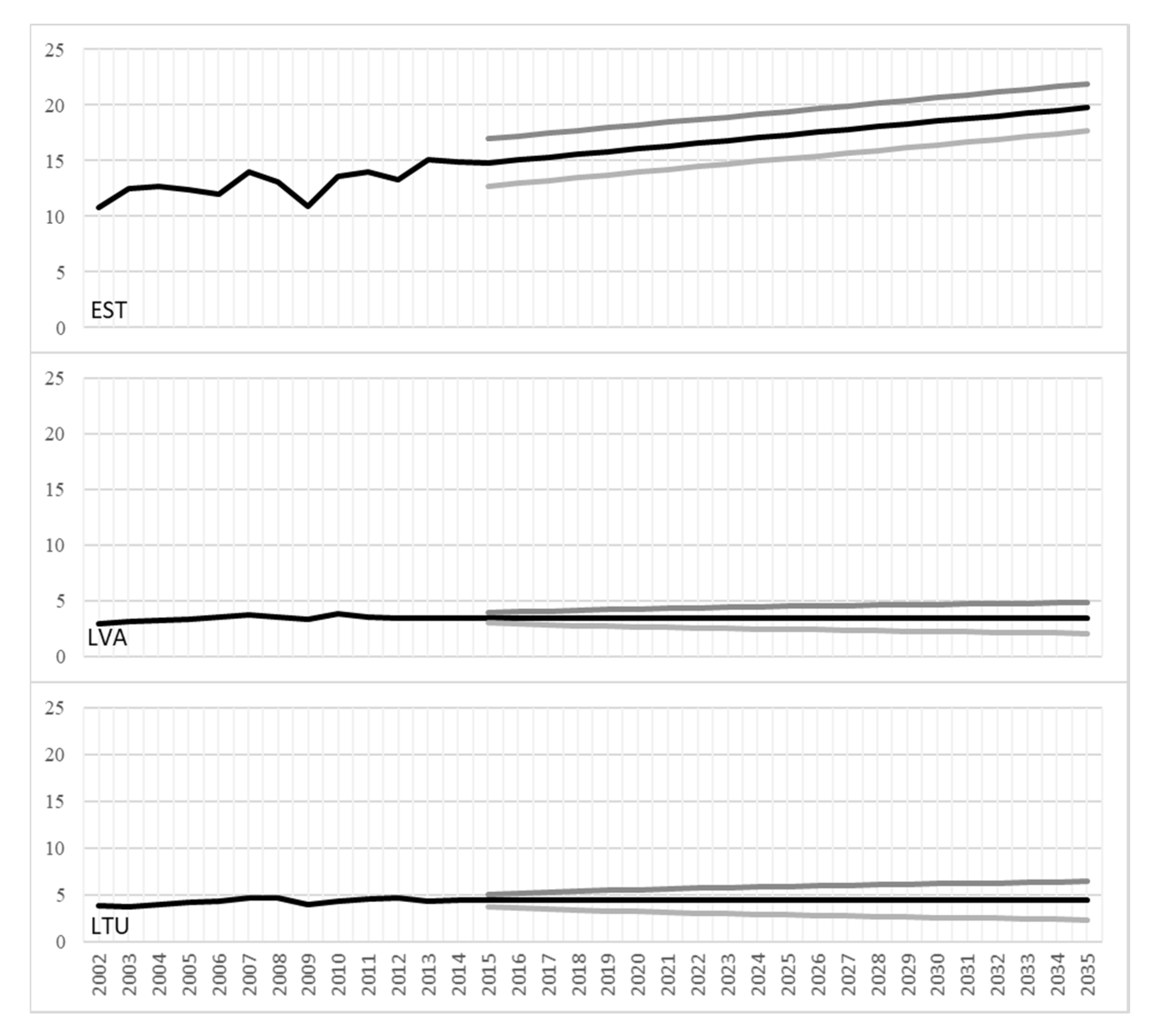
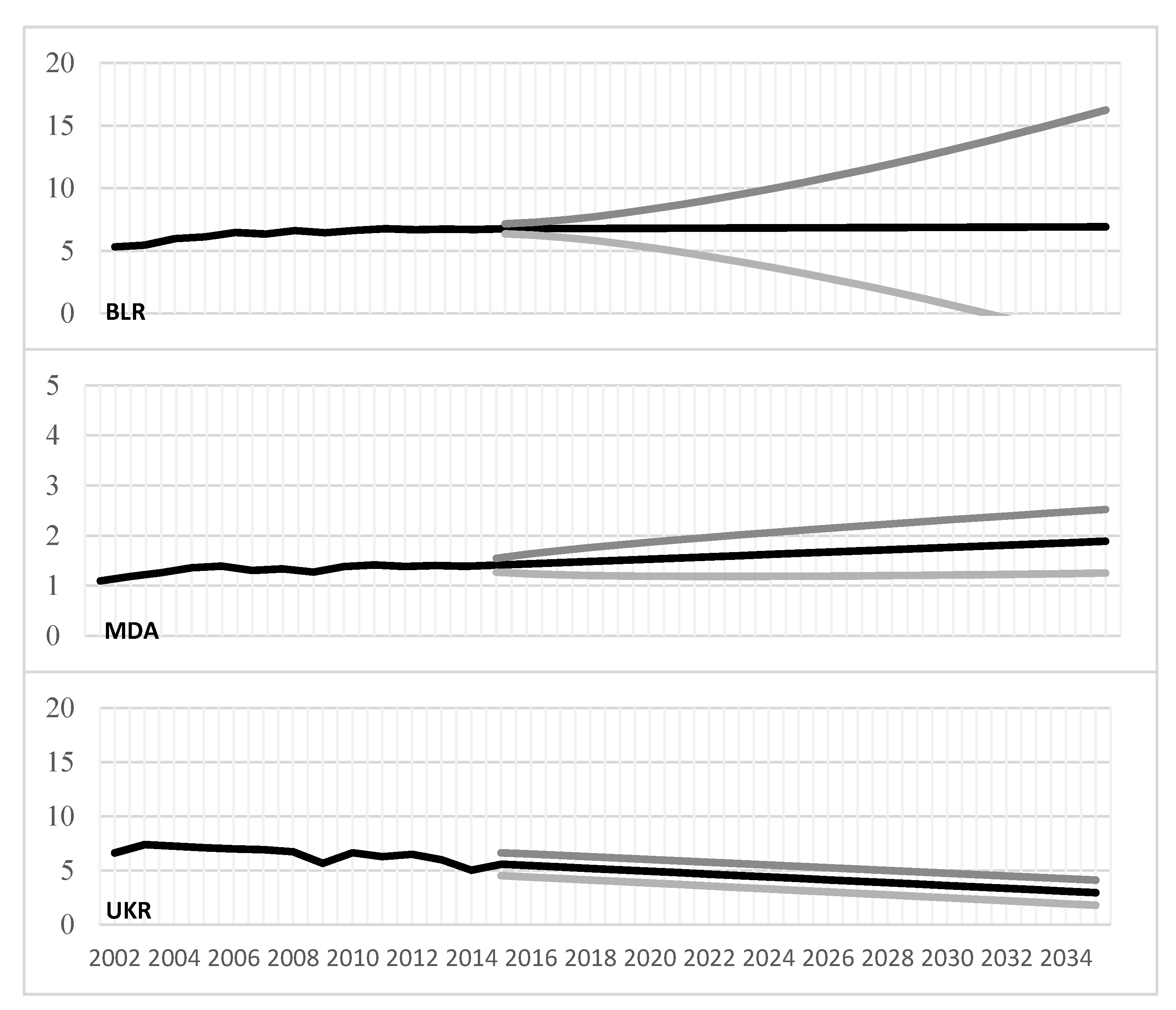

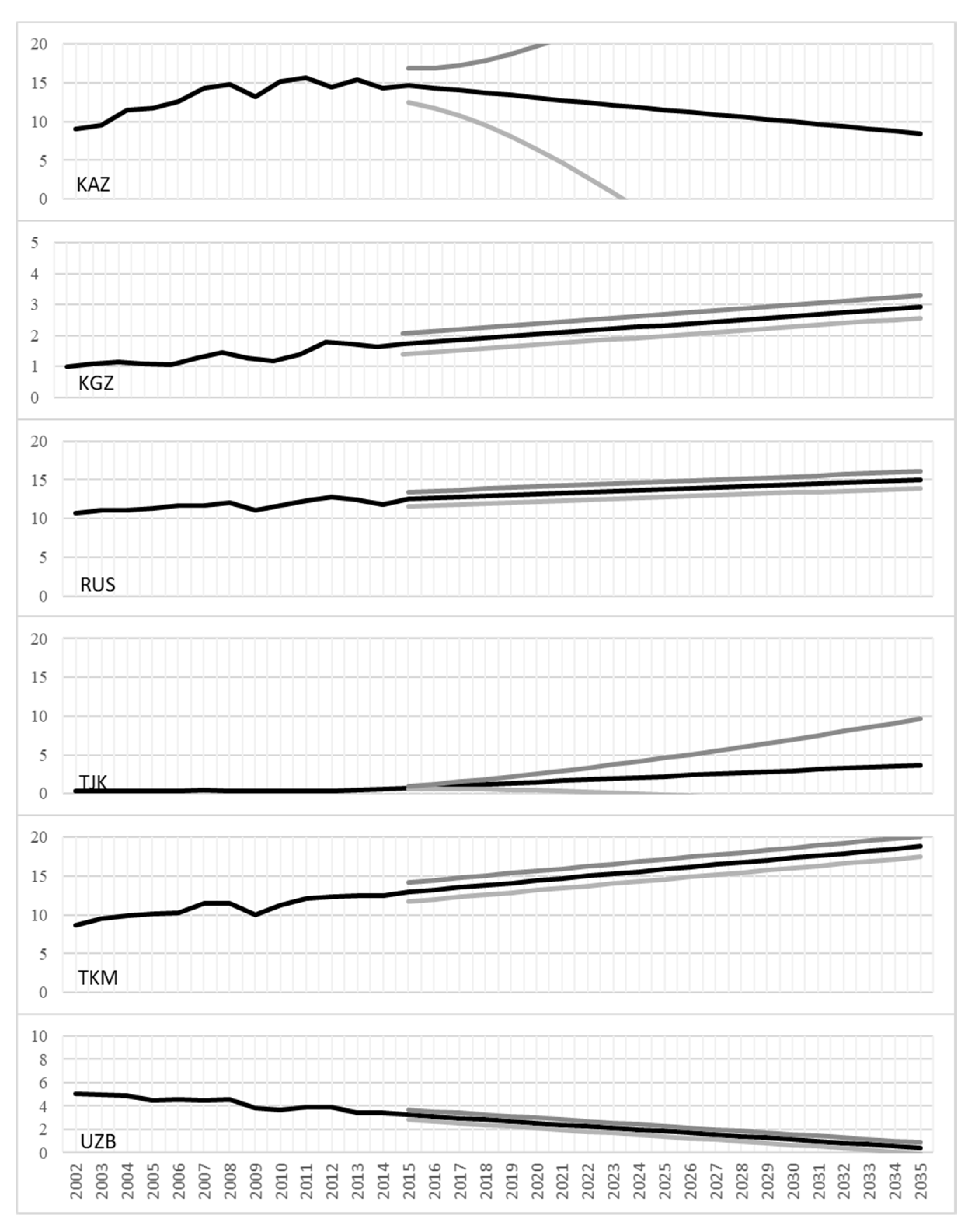
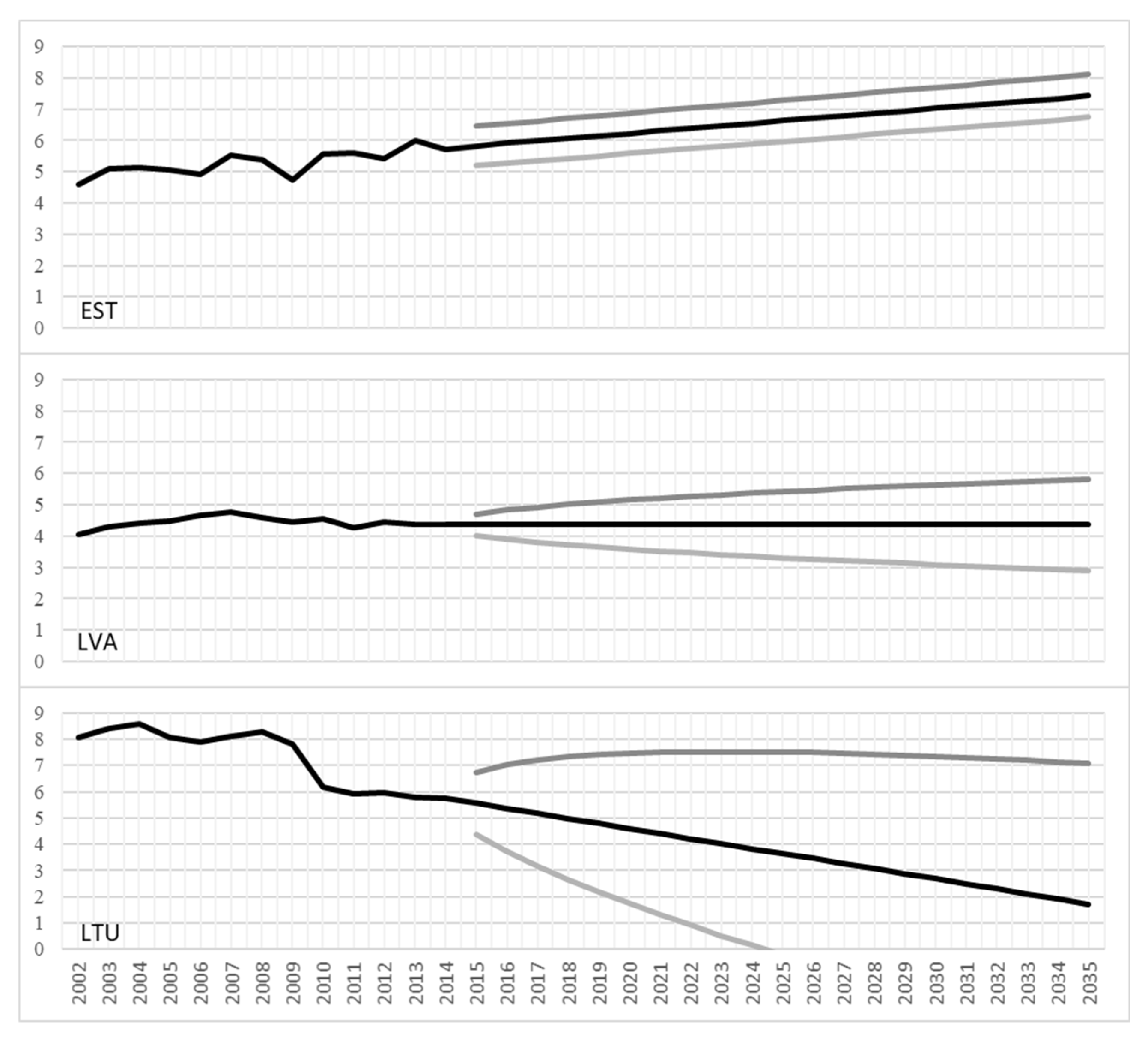
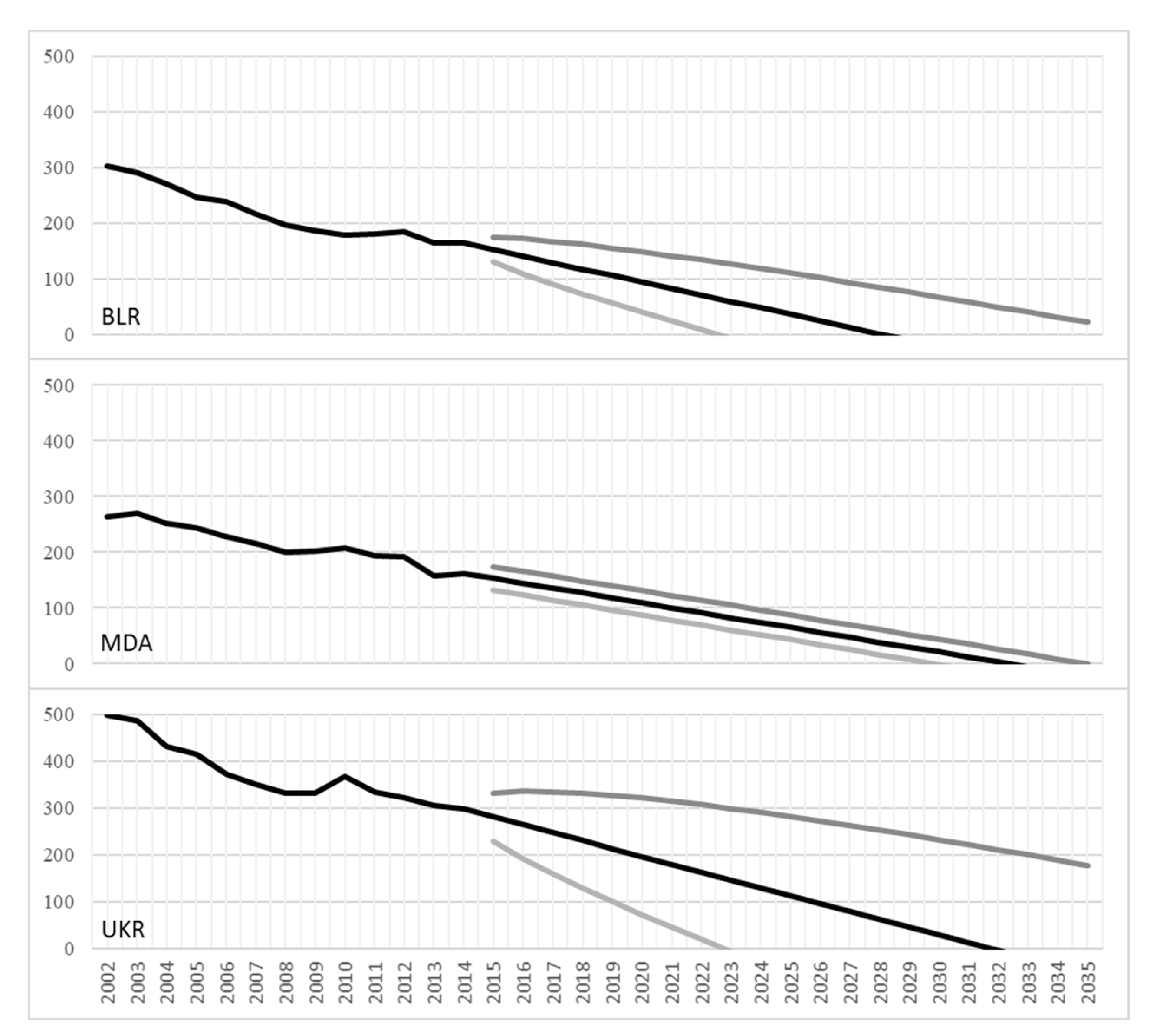

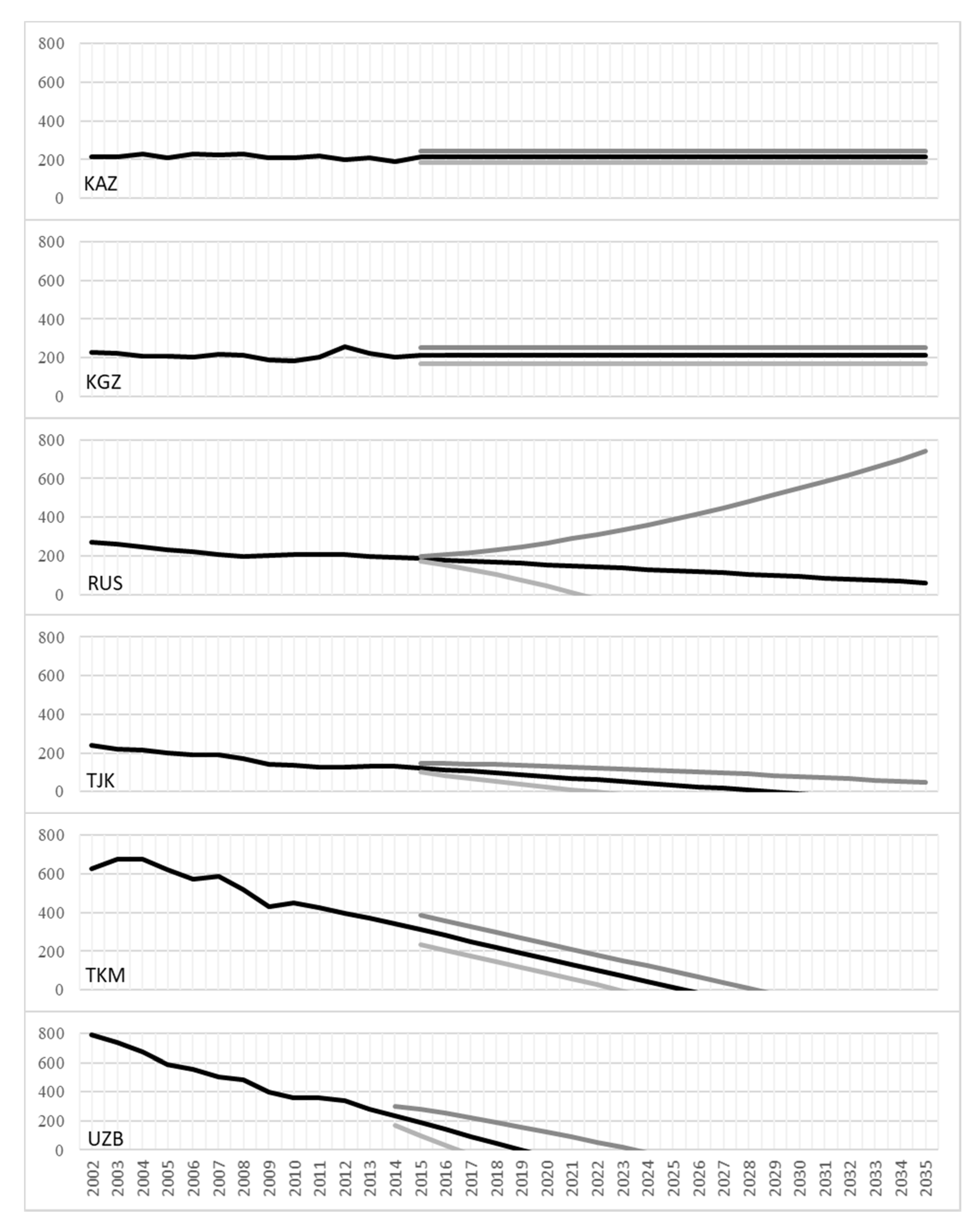
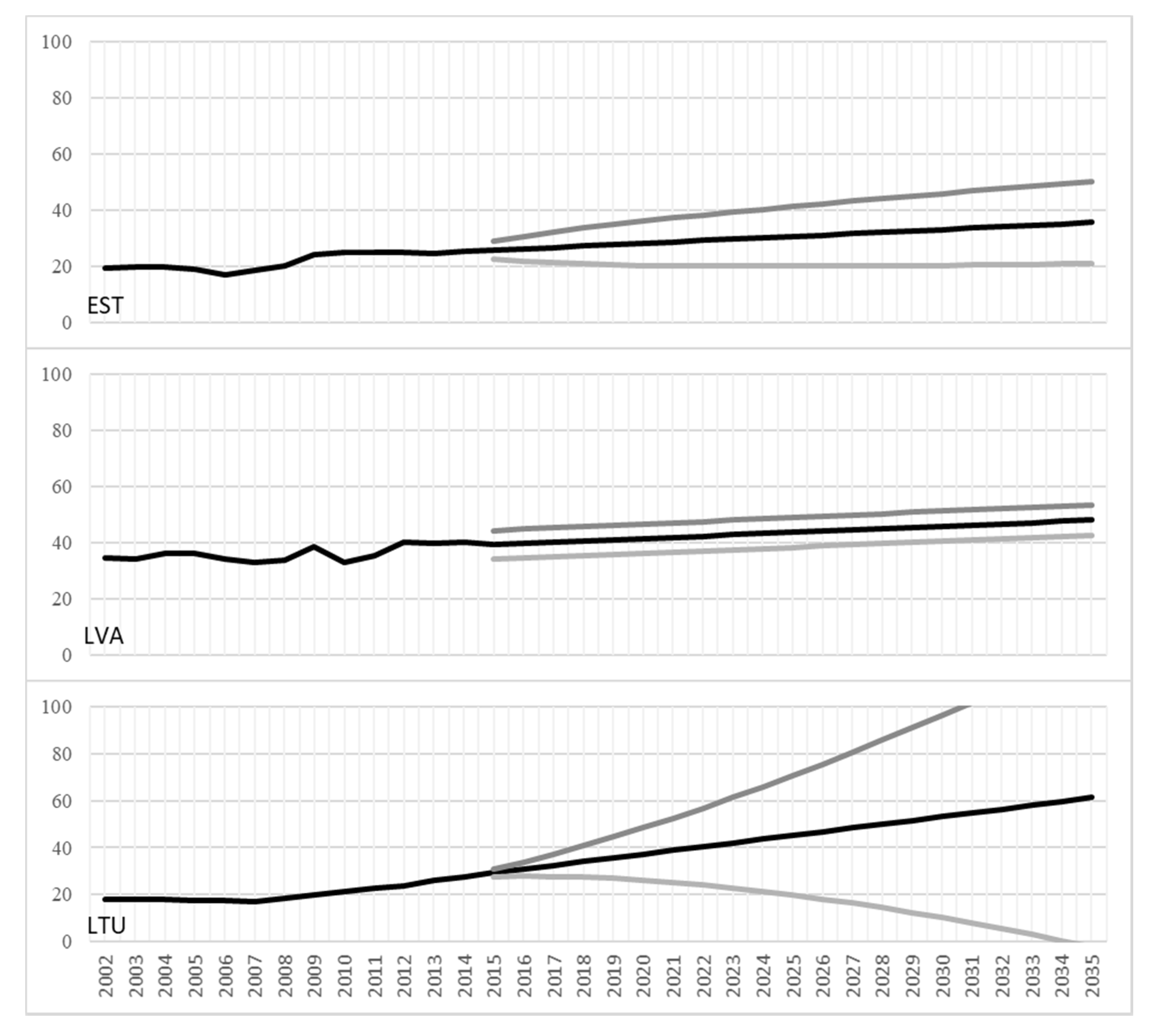

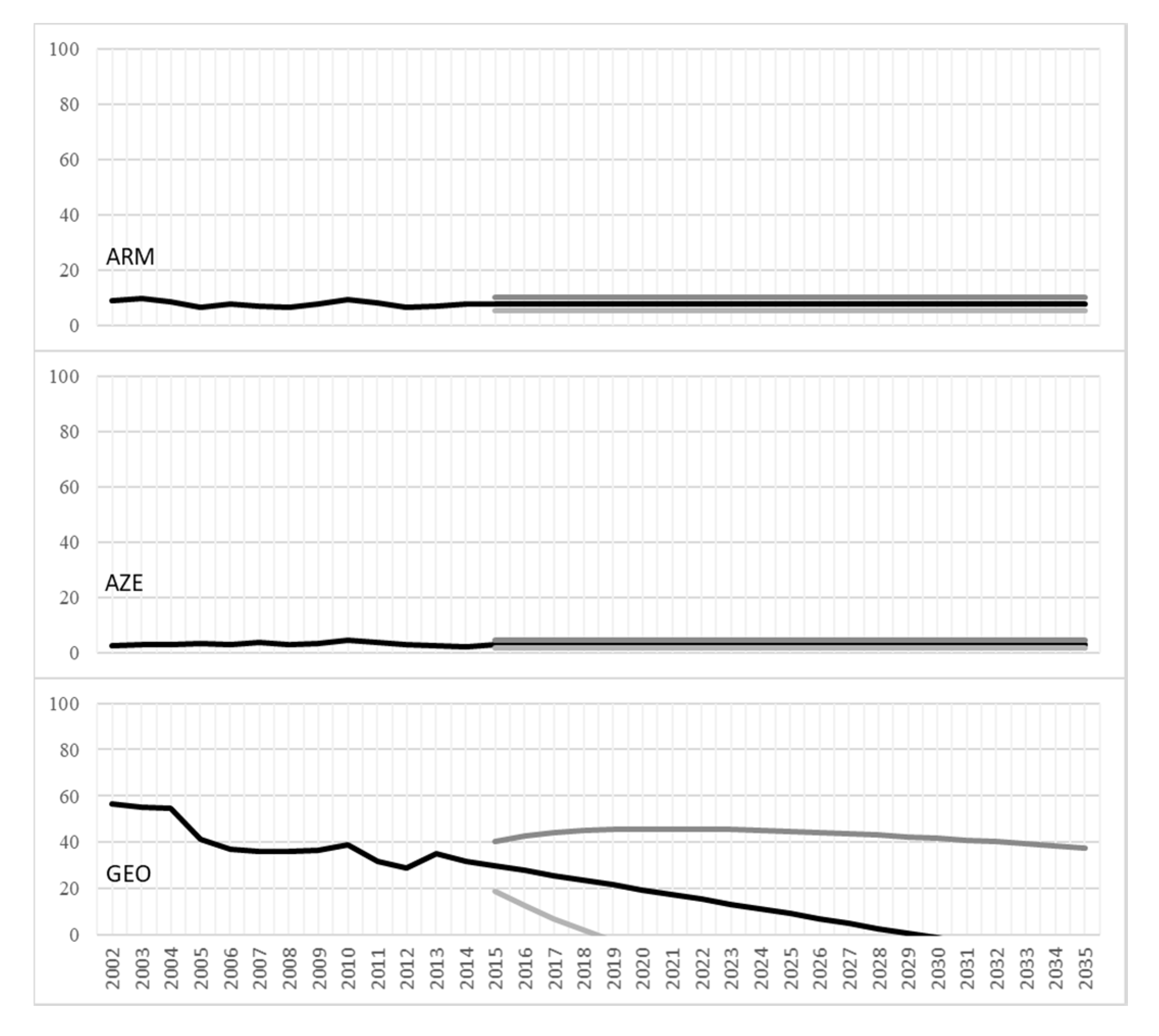
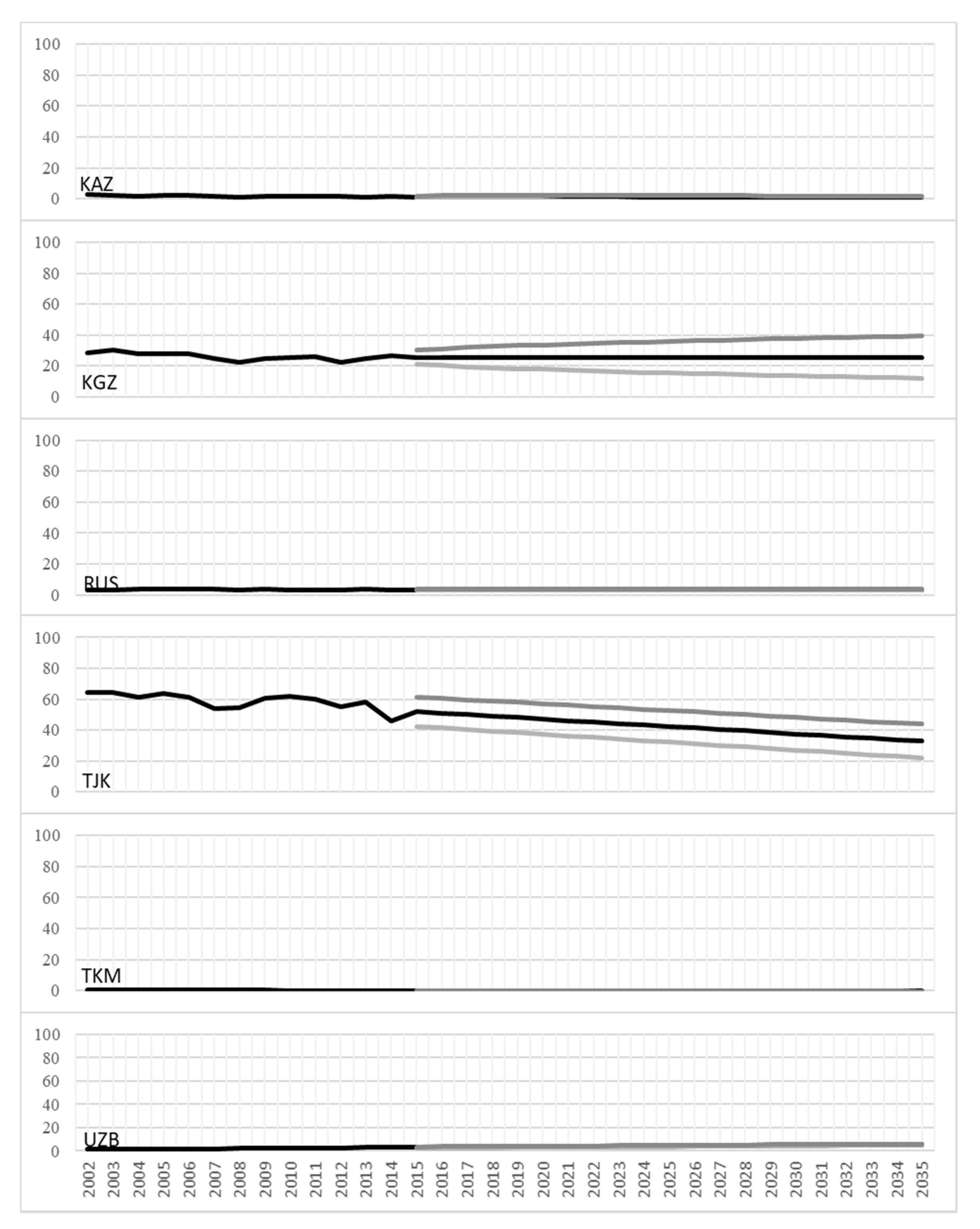
| Country | Carbon Emissions Targets | Energy Intensity (EI)/Energy Consumption Targets | Renewable Energy (RE) Targets |
|---|---|---|---|
| Eastern Europe | |||
| Belarus | Reduce CO2 emissions by 28%, compared to the 1990 level until 2030 [69]. | Reduce GDP EI to 37% until 2035, compared to the 2010 level [70]. | Reaching 9% RE of final energy consumption by 2035 [70]. |
| Moldova | Reduce CO2 emissions by 64–67% until 2030, compared to 1990 [71]. | No long-term targets. | No long-term targets. |
| Ukraine | Reduce CO2 emissions by 40%, compared to the 1990 level until 2030 [72,73]. | Reduce energy consumption by 28% by 2030 [73]. | Reaching 17% RE of final energy consumption by 2030 [73]. |
| Eurasia | |||
| Russia | Reduce CO2 emissions for 30–35%, compared to the 1990 level by 2030 [74]. | Reduce EI to 50% compared to 2010 level by 2035 [75]. | Not presented in Russia’s Energy Strategy in the Period until 2035 [75]. |
| Transcaucasia | |||
| Armenia | CO2 emissions 2.07 tons/per capita annually, by 2030 [76]. | No target. | No target. |
| Azerbaijan | Reduce CO2 emissions by 35% compared to the 1990 level by 2030 [77]. | Strategy in development [78]. | Strategy in development [78]. |
| Georgia | Reduce CO2 emissions by 15% below BAU by 2030 [79]. | Strategy in development [78]. | Strategy in development [78]. |
| Central Asia | |||
| Kazakhstan | Reduce CO2 emissions by 15–25% compared to the 1990 level by 2030 [80]. | Reduce GDP EI by 30% until 2030, compared to the 2008 level [81]. | Reaching 30% RE of final energy consumption by 2030 [81]. |
| Kyrgyzstan | Reduce CO2 emissions by 11.39–13.75% below BAU by 2030 [82]. | Strategy in development [78]. | Strategy in development [78]. |
| Tajikistan | Reduce CO2 emissions by 10–20% compared to the 1990 level by 2030 [83]. | Strategy in development [78]. | Strategy in development [78]. |
| Turkmenistan | Stabilization of emissions on the 2010 level by 2030 [84]. | Strategy in development [78]. | Strategy in development [78]. |
| Uzbekistan | Reduce CO2 emissions per unit of GDP by 10% by 2030, compared to level of 2010 [85]. | Strategy in development [78]. | Strategy in development [78]. |
| European Union | |||
| Estonia | Reduce greenhouse gas (GHG) emissions by 13% of the 2005 level by 2030 [86]. | Overall target of energy efficiency: primary energy consumption in 2030 <5.49 Mtoe [86]. | Share of energy produced from RES in gross final energy consumption: 42% [86]. |
| Latvia | Reduce GHG emissions by 6% of the 2005 level by 2030 [87]. | Optional target—primal energy consumption <4.3 Mtoe by 2030 [87]. | Share of energy produced from RES in gross final energy consumption: 45% [87]. |
| Lithuania | Reduce COemissions by 9% of the 2005 level by 2030 [88]. | Reducing energy intensity 1.5 times by 2030, compared to 2018 [88]. | Increasing the share of renewable energy to at least 45% [88]. |
| Predictor | Estimate | SE | t | p | Stand. Estimate | |
|---|---|---|---|---|---|---|
| Baltics (members of the EU) | ||||||
| Estonia | Adjusted R2 = 0.583, F(2,10) = 9.40, p = 0.005, dependent—MTOE | |||||
| Intercept | 1.8938 | 0.7856 | 2.41 | 0.037 | ||
| Estonia REC | 0.0585 | 0.0251 | 2.33 | 0.042 | 0.442 | |
| Estonia GDP | 6.66 × 10−11 | 2.11 × 10−11 | 3.16 | 0.01 | 0.599 | |
| Latvia | Adjusted R2 = 0.648, F(2,10) = 12.00, p = 0.002, dependent—MTOE | |||||
| Intercept | 4.3092 | 0.4638 | 9.29 | <0.001 | ||
| Latvia REC | −0.0277 | 0.0119 | −2.33 | 0.042 | −0.404 | |
| Latvia GDP | 2.8 × 10−11 | 6.1 × 10−12 | 4.6 | <0.001 | 0.796 | |
| Lithuania | Adjusted R2 = 0.805, F(2,10) = 25.80, p < 0.001, dependent—MTOE | |||||
| Intercept | 13.476 | 1.1274 | 11.953 | <0.001 | ||
| Lithuania REC | −0.279 | 0.049 | −5.703 | <0.001 | −0.8835 | |
| Lithuania GDP | −6.98 × 10−12 | 2 × 10−11 | −0.347 | 0.736 | −0.0538 | |
| Eastern Europe | ||||||
| Belarus | Adjusted R2 = 0.959, F(2,10) = 143.00, p < 0.001, dependent—KOE | |||||
| Intercept | 409.74 | 51.1 | 8.018 | <0.001 | ||
| Belarus REC | 2.85 | 11.8 | 0.241 | 0.814 | 0.0346 | |
| Belarus GDP | −1.59 × 10−9 | 2.2 × 10−10 | −7.075 | <0.001 | −1.0145 | |
| Moldova | Adjusted R2 = 0.949, F(2,10) = 113.00, p < 0.001, dependent—KOE | |||||
| Intercept | 436.553 | 17.85 | 24.453 | <0.001 | ||
| Moldova REC | 0.695 | 1.17 | 0.595 | 0.565 | 0.064 | |
| Moldova GDP | −1.42 × 10−8 | 1.5 × 10−9 | −9.565 | <0.001 | −1.0286 | |
| Ukraine | Adjusted R2 = 0.942, F(2,10) = 99.2, p < 0.001, dependent—KOE | |||||
| Intercept | 723.8 | 49.24 | 14.7 | <0.001 | ||
| Ukraine REC | −47.6 | 6.7 | −7.1 | <0.001 | −0.668 | |
| Ukraine GDP | −6.81 × 10−10 | 1.6 × 10−10 | −4.16 | 0.002 | −0.391 | |
| Transcaucasia | ||||||
| Armenia | Adjusted R2 = 0.946, F(2,10) = 105.00, p < 0.001, dependent—KOE | |||||
| Intercept | 251.95 | 11.447 | 22.01 | <0.001 | ||
| Armenia REC | −5.02 | 0.955 | −5.26 | <0.001 | −0.458 | |
| Armenia GDP | −3.84 × 10−9 | 2.8 × 10−10 | −13.79 | <0.001 | −1.202 | |
| Azerbaijan | Adjusted R2 = 0.959, F(2,10) = 141.00, p < 0.001, dependent—KOE | |||||
| Intercept | 361.6 | 22.18 | 16.31 | <0.001 | ||
| Azerbaijan REC | −17.5 | 6.64 | −2.63 | 0.025 | −0.156 | |
| Azerbaijan GDP | −1.51 × 10−9 | 9.4 × 10−11 | −16.08 | <0.001 | −0.951 | |
| Georgia | Adjusted R2 = 0.663, F(2,10) = 12.80, p = 0.002, dependent—KOE | |||||
| Intercept | 92.05 | 44.797 | 2.055 | 0.067 | ||
| Georgia REC | 1.14 | 0.55 | 2.071 | 0.065 | 0.7875 | |
| Georgia GDP | −1.63 × 10−10 | 9.3 × 10−10 | −0.176 | 0.864 | −0.0668 | |
| Eurasia and Central Asia | ||||||
| Kazakhstan | Adjusted R2 = 0.291, F(2,10) = 3.46, p = 0.072, dependent—KOE | |||||
| Intercept | 304.6 | 44 | 6.92 | <0.001 | ||
| Kazakhstan REC | −17.8 | 11.9 | −1.49 | 0.168 | −0.719 | |
| Kazakhstan GDP | −2.02 × 10−10 | 8.5 × 10−11 | −2.38 | 0.039 | −1.149 | |
| Kyrgyzstan | Adjusted R2 = −0.121, F(2,10) = 3.46, p = 0.712, dependent—KOE | |||||
| Intercept | 304.32 | 110.13 | 2.763 | 0.02 | ||
| Kyrgyzstan REC | −2.43 | 3.01 | −0.808 | 0.438 | −0.313 | |
| Kyrgyzstan GDP | −2.01 × 10−9 | 3 × 10−9 | −0.674 | 0.515 | −0.261 | |
| Russian Federation | Adjusted R2 = 0.923, F(2,10) = 72.70, p < 0.001, dependent—KOE | |||||
| Intercept | 445.8 | 47.2 | 9.45 | <0.001 | ||
| Russian Federation REC | −16.9 | 12.9 | −1.31 | 0.22 | −0.105 | |
| Russian Federation GDP | −5.33 × 10−11 | 4.4 × 10−12 | −12 | <0.001 | −0.963 | |
| Tajikistan | Adjusted R2 = 0.918, F(2,10) = 55.80, p < 0.001, dependent—KOE | |||||
| Intercept | 488.79 | 74.451 | 6.57 | <0.001 | ||
| Tajikistan REC | −2.39 | 0.995 | −2.41 | 0.037 | −0.316 | |
| Tajikistan GDP | −1.21 × 10−8 | 1.4 × 10−9 | −8.85 | <0.001 | −1.161 | |
| Turkmenistan | Adjusted R2 = 0.959, F(2,10) = 142.00, p < 0.001, dependent—KOE | |||||
| Intercept | 1164 | 96.4 | 12.07 | <0.001 | ||
| Turkmenistan REC | −3312 | 878.1 | −3.77 | 0.004 | −0.475 | |
| Turkmenistan GDP | −9.23 × 10−9 | 8.4 × 10−10 | −10.95 | <0.001 | −1.379 | |
| Uzbekistan | Adjusted R2 = 0.907, F(2,9) = 54.90, p < 0.001, dependent—KOE | |||||
| Intercept | 1115.7 | 63.2 | 17.647 | <0.001 | ||
| Uzbekistan REC | −51.8 | 56.4 | −0.918 | 0.383 | −0.159 | |
| Uzbekistan GDP | −3.96 × 10−9 | 8.3 × 10−10 | −4.76 | 0.001 | −0.823 | |
| Predictor | Estimate | SE | t | p | Stand. Estimate | |
|---|---|---|---|---|---|---|
| Baltics (members of the EU) | ||||||
| Estonia | Adjusted R2 = 0.523, F(2,10) = 7.57, p = 0.010, dependent—GHG | |||||
| Intercept | 2.339 | 2.7641 | 0.846 | 0.417 | ||
| Estonia REC | 0.161 | 0.0884 | 1.827 | 0.098 | 0.371 | |
| Estonia GDP | 2.25 × 10−10 | 7.43 × 10−11 | 3.032 | 0.013 | 0.616 | |
| Latvia | Adjusted R2 = 0.630, F(2,10) = 11.20, p = 0.003, dependent—GHG | |||||
| Intercept | 2.9942 | 0.5942 | 5.04 | <0.001 | ||
| Latvia REC | −0.0269 | 0.0152 | −1.77 | 0.108 | −0.313 | |
| Latvia GDP | 3.6 × 10−11 | 7.8 × 10−12 | 4.6 | <0.001 | 0.816 | |
| Lithuania | Adjusted R2 = 0.751, F(2,10) = 19.10, p < 0.001, dependent—GHG | |||||
| Intercept | 2.3342 | 0.3641 | 6.41 | <0.001 | ||
| Lithuania REC | −0.0285 | 0.0158 | −1.8 | 0.102 | −0.315 | |
| Lithuania GDP | 3.8 × 10−11 | 6.5 × 10−12 | 5.89 | <0.001 | 1.031 | |
| Eastern Europe | ||||||
| Belarus | Adjusted R2 = 0.849, F(2,10) = 34.70, p < 0.001, dependent—GHG | |||||
| Intercept | 3.82 | 0.981 | 3.895 | 0.003 | ||
| Belarus REC | 0.135 | 0.226 | 0.598 | 0.563 | 0.165 | |
| Belarus GDP | 1.2 × 10−11 | 4.3 × 10−12 | 2.826 | 0.018 | 0.781 | |
| Moldova | Adjusted R2 = 0.674, F(2,10) = 13.40, p = 0.001, dependent—GHG | |||||
| Intercept | 0.7383 | 0.12012 | 6.15 | <0.001 | ||
| Moldova REC | −0.012 | 0.00785 | −1.52 | 0.158 | −0.414 | |
| Moldova GDP | 4.2 × 10−11 | 1 × 10−11 | 4.21 | 0.002 | 1.145 | |
| Ukraine | Adjusted R2 = 0.803, F(2,10) = 25.40, p < 0.001, dependent—GHG | |||||
| Intercept | 4.601 | 0.92 | 5 | <0.001 | ||
| Ukraine REC | −0.873 | 0.125 | −6.97 | <0.001 | −1.214 | |
| Ukraine GDP | 1.1 × 10−11 | 3.1 × 10−12 | 3.62 | 0.005 | 0.631 | |
| Transcaucasia | ||||||
| Armenia | Adjusted R2 = 0.961, F(2,10) = 149.00, p < 0.001, dependent—GHG | |||||
| Intercept | 0.8429 | 0.2472 | 3.41 | 0.007 | ||
| Armenia REC | −0.0654 | 0.0206 | −3.17 | 0.01 | −0.234 | |
| Armenia GDP | 6.7 × 10−11 | 6 × 10−12 | 11.11 | <0.001 | 0.819 | |
| Azerbaijan | Adjusted R2 = 0.018, F(2,10) = 1.11, p = 0.366, dependent—GHG | |||||
| Intercept | 4.535 | 0.487 | 9.311 | <0.001 | ||
| Azerbaijan REC | −0.195 | 0.146 | −1.334 | 0.212 | −0.385 | |
| Azerbaijan GDP | −1.01 × 10−12 | 2.1 × 10−12 | −0.49 | 0.635 | −0.141 | |
| Georgia | Adjusted R2 = 0.905, F(2,10) = 58.00, p < 0.001, dependent—GHG | |||||
| Intercept | 0.10352 | 0.8779 | 0.118 | 0.908 | ||
| Georgia REC | −0.0089 | 0.0108 | −0.826 | 0.428 | −0.167 | |
| Georgia GDP | 7.3 × 10−11 | 1.8 × 10−11 | 3.992 | 0.003 | 0.807 | |
| Eurasia and Central Asia | ||||||
| Kazakhstan | Adjusted R2 = 0.821, F(2,10) = 28.50, p < 0.001, dependent—GHG | |||||
| Intercept | 13.24 | 3.88 | 3.41 | 0.007 | ||
| Kazakhstan REC | −2.3 | 1.05 | −2.18 | 0.054 | −0.531 | |
| Kazakhstan GDP | 1.3 × 10−11 | 7.5 × 10−12 | 1.74 | 0.112 | 0.424 | |
| Kyrgyzstan | Adjusted R2 = 0.752, F(2,10) = 19.20, p < 0.001, dependent—GHG | |||||
| Intercept | 0.93 | 0.7406 | 1.26 | 0.238 | ||
| Kyrgyzstan REC | −0.0286 | 0.0202 | −1.41 | 0.188 | −0.257 | |
| Kyrgyzstan GDP | 7.8 × 10−11 | 2 × 10−11 | 3.9 | 0.003 | 0.71 | |
| Russian Federation | Adjusted R2 = 0.708, F(2,10) = 15.60, p < 0.001, dependent—GHG | |||||
| Intercept | 10.6 | 2.156 | 4.92 | <0.001 | ||
| Russian Federation REC | −0.696 | 0.591 | −1.18 | 0.267 | −0.183 | |
| Russian Federation GDP | 1.1 × 10−12 | 2E−13 | 5.44 | <0.001 | 0.848 | |
| Tajikistan | Adjusted R2 = 0.742, F(2,10) = 18.20, p < 0.001, dependent—GHG | |||||
| Intercept | 1.3681 | 0.26106 | 5.241 | <0.001 | ||
| Tajikistan REC | −0.016 | 0.00349 | −4.583 | 0.001 | −0.973 | |
| Tajikistan GDP | −2.87 × 10−12 | 4.8 × 10−12 | −0.597 | 0.563 | −0.127 | |
| Turkmenistan | Adjusted R2 = 0.774, F(2,10) = 21.50, p < 0.001, dependent—GHG | |||||
| Intercept | 10.5 | 2.37 | 4.43 | 0.001 | ||
| Turkmenistan REC | −22.4 | 21.61 | −1.04 | 0.324 | −0.308 | |
| Turkmenistan GDP | 4.3 × 10−11 | 2.1 × 10−11 | 2.08 | 0.064 | 0.617 | |
| Uzbekistan | Adjusted R2 = 0.890, F(2,10) = 49.40, p < 0.001, dependent—GHG | |||||
| Intercept | 6.242 | 0.221 | 28.2 | <0.001 | ||
| Uzbekistan REC | −0.264 | 0.214 | −1.23 | 0.246 | −0.248 | |
| Uzbekistan GDP | −1.09 × 10−11 | 3 × 10−12 | −3.62 | 0.005 | −0.728 | |
© 2020 by the authors. Licensee MDPI, Basel, Switzerland. This article is an open access article distributed under the terms and conditions of the Creative Commons Attribution (CC BY) license (http://creativecommons.org/licenses/by/4.0/).
Share and Cite
Matiiuk, Y.; Poškus, M.S.; Liobikienė, G. The Implementation of Climate Change Policy in Post-Soviet Countries Achieving Long-Term Targets. Sustainability 2020, 12, 4558. https://doi.org/10.3390/su12114558
Matiiuk Y, Poškus MS, Liobikienė G. The Implementation of Climate Change Policy in Post-Soviet Countries Achieving Long-Term Targets. Sustainability. 2020; 12(11):4558. https://doi.org/10.3390/su12114558
Chicago/Turabian StyleMatiiuk, Yuliia, Mykolas Simas Poškus, and Genovaitė Liobikienė. 2020. "The Implementation of Climate Change Policy in Post-Soviet Countries Achieving Long-Term Targets" Sustainability 12, no. 11: 4558. https://doi.org/10.3390/su12114558
APA StyleMatiiuk, Y., Poškus, M. S., & Liobikienė, G. (2020). The Implementation of Climate Change Policy in Post-Soviet Countries Achieving Long-Term Targets. Sustainability, 12(11), 4558. https://doi.org/10.3390/su12114558







